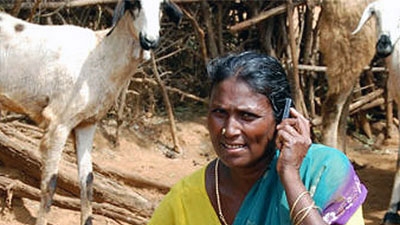Smallholder farmers, who still provide a significant portion of the world’s food, need information to advance their work just as much as industrial-scale producers, but they often lack access to simple tools and technologies that can provide essential information on prices, markets, varieties, production techniques, services, storage, or processing. As a result, smallholder farmers remain dependent primarily on word of mouth, previous experience, and local leadership. But this is changing as the types of ICT-enabled services useful to improving the capacity and livelihoods of poor smallholders are growing quickly. For example, short messaging service (SMS) is now enabling mobile phones to be used as a platform for agricultural information exchange.
Reuters Market Light services over 200,000 smallholder subscribers in 10 different states in India for a cost of $1.50 per month. The farmers receive four to five SMS messages per day on prices, commodities, and advisory services from a database with information on 150 crops and more than 1,000 markets. Preliminary evidence suggests that collectively, the service may have generated $2–3 billion in income for farmers, while over 50 percent of them have reduced their spending on agriculture inputs.
The World Bank has actively participated in the integration of ICT in large agricultural investments. After Uruguay was struck by a virulent outbreak of Foot and Mouth Disease (FMD) in 2001, the Bank provided $25 million through loans and grants to generate and scale out an innovative animal tracking system that contributed to the eradication of FMD in Uruguay, which has become a globally-recognized model for effective food safety and surveillance. Portfolio reviews show that 80 percent of Bank agriculture projects already contain ICT components; however, most of these components are for administrative purposes such as delivering computers to client country offices. With the increased affordability and uptake of new technologies, the Bank has increased opportunity to invest in and impact small-scale farmers more directly.
"ICT in agriculture is at present an area of 'let a thousand flowers bloom' with plenty of exciting anecdotal evidence," said Eija Pehu, science advisor with the World Bank’s Agriculture and Rural Development Department and one of the coordinators of the report. "It can be transformative. It gives a voice and access to information to small-scale farmers including women, who never had such direct access before."
The recently launched ICT in Agriculture e-Sourcebook produced by World Bank’s Agriculture and Rural Development Department and infoDev (a technology and innovation trust fund program in the Financial and Private Sector Network), with funding from the Ministry for Foreign Affairs of Finland, is an online resource that provides both technical as well as policy guidance to practitioners and decision makers in developing countries, international organizations and bilateral agencies. The goal is to capture the rapidly evolving ICT environment as a pivotal change factor for agricultural productivity and rural development.
The e-Sourcebook is a compilation of modules related to 14 agricultural subsectors. Each module covers the challenges, lessons learned, and enabling factors associated with using ICT to improve smallholder livelihoods in these subsectors. Over 200 examples and case studies across the regions are presented. It is fully and freely available on the web at http://www.ICTinagriculture.org.
"It was a conscious decision to publish the report as an e-Sourcebook, and then host an interactive e-Forum with partners," says Tim Kelly, lead ICT specialist and one of the coordinators of the report. "ICTs continue to evolve rapidly and so to remain relevant, this has to be an open source of information, with ample opportunities for knowledge exchange and updating," he explains.

